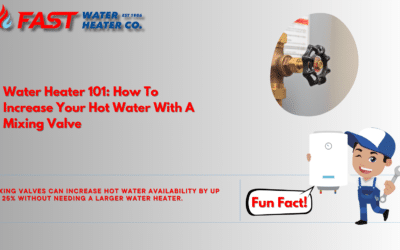Blog
How to Safely Remove an Old Water Heater: A Step-by-Step Guide
Removing an old water heater might seem daunting, but with the right approach, it can be done safely and efficiently. In this guide, we'll walk you through the process step-by-step, as explained by Steve from Fast Water Heater Company. Step 1: Drain the Water Heater...
How to Troubleshoot an Electric Water Heater: A Step-by-Step Guide
Welcome to another installment of our Water Heater 101 series! Today, we're diving into the world of electric water heaters with a practical guide on troubleshooting. Whether you're a DIY enthusiast or just looking to understand your home appliances better, this guide...
Water Heater 101: How to Increase Your Hot Water Capacity with a Mixing Valve
Hello, I'm Steve from Fast Water Heater Company, and today I'm excited to share with you a handy tip on how to get more hot water from your water heater using a mixing valve. The Challenge of New Efficiency Standards In April 2015, new efficiency standards...
Water Heater 101: Tankless Efficiency in Downtown Buildings
As we delve into the essentials of tankless water heaters, we'll explore how these systems address the unique needs of residents and businesses in downtown environments, offering optimal efficiency for both urban living and commercial spaces. Tankless Water Heaters...
Water Heater 101: Understanding Installation Costs and Price Factors
Welcome to Water Heater 101, where we delve into the crucial aspects of water heater installation costs. Whether you're considering an upgrade to a more energy-efficient model or replacing an aging unit, having a comprehensive understanding of the key factors...
Water Heater 101: Fixing a Leaking Water Tank
A leaking water heater can cause a lot of problems for homeowners. Water damage, mold growth, and high energy costs are just a few of the risks associated with a leaky water heater. If you’re currently experiencing this issue, the question on your mind is likely: can...
Water Heater 101: The 4 Most Efficient Water Heaters
Water heaters have become an essential part of our daily lives. From taking warm showers to cooking, water heaters play a crucial role. However, ss energy costs continue to rise, many homeowners are looking for an alternative to reduce their energy consumption. This...
Water Heater 101: When Do I Need To Repair or Replace My Water Tank?
We all know the feeling of jumping into a steaming hot shower or doing a load of dishes with hot water, only to be met with cold water instead. It's a dreadful experience and a clear indication that there's something wrong with your hot water heater. But how do you...
Water Heater 101: Seeking the Most Reliable Water Tank Brand
A steady supply of hot water is essential for many households. From cooking to cleaning and bathing, we rely on hot water in our daily activities. That's why having a reliable hot water heater is a must. But with so many options out there, how do you know which brand...
Water Heater 101: Understanding How Tankless Water Heaters Work
Many homeowners rave about their tankless water heaters. Now, you may be asking yourself, “What’s the big deal?” Well, unlike traditional water heaters, these tankless units don’t have a storage tank. Instead, they provide an endless supply of hot water by heating up...
Water Heater 101: 7 Steps To Extend Your Heater’s Lifespan
It’s pretty safe to say that we all wish the appliances, systems, and devices in our homes would last forever. However, this is unfortunately not the reality of the situation. At some point or another, practically everything in your home will need to be replaced —...
Water Heater 101: 3 Common Issues With Anode Rods
When you consider your water heater, you probably only think about the hot water it provides your family with. However, this important appliance has many moving parts that allow it to get its job done without any hassle — including the anode rod. All tank-style water...
Water Heater 101: 4 Ways To Identify a Water Heater Emergency
The water heater in your home is responsible for your hot water supply. You count on this trusty appliance during every month of the year, whether you need to wash the dishes or want to take a nice, warm shower. However, just like any other appliance, your water...
Water Heater 101: 3 Major Reasons to Regularly Flush Your Tank
The water heater in your home is responsible for providing hot water whenever you need it. Therefore, it’s important to flush the tank occasionally to keep this water heater running smoothly. If you’re a homeowner, you have many tasks that need to be done — and...
Water Heater 101: What Is The Right Water Heater Temperature
When you install a hot water heater in your home, the unit will usually be placed at a specific temperature that’s dictated by the manufacturer. However, just because your water heater is installed at a certain temperature doesn’t mean you can’t change it. Is your...















